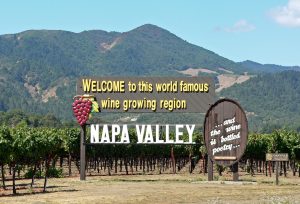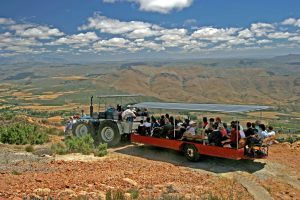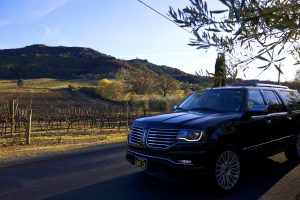It is no surprise that with wine consumption rising throughout the United States and globally, wine tourism is also rising. In 2016, according to data from Wine Institute, Americans consumed 2.94 gallons of wine per capita, adding to a total of 949 million gallons across the

Photo by Stan Shebs, Wikimedia Commons
entire U.S. Americans, like many others around the globe, are also increasingly planning their vacations around wine. In Napa Valley alone, tourism dollars to the famous wine region increased by 25.2% from 2014 to 2016, with tourists providing a $80.3 million tax revenue boost for the county in 2016 (Visit Napa Valley statistics). Looking at California as a whole, the average wine tourist spent about $3,180 annually in 2017, with much of that money spent in wineries, restaurants, at events or festivals, and also at other non-wine local attractions such as local and state parks (Wine Institute data).
Wine Tourism: Defined
According to Mintel, ‘wine tourism’ is defined as “tourism whose purpose includes visiting vineyards, wineries, wine festivals and events, during which the tasting and consumption of wine and experiencing the attributes of the wine-growing region are the primary motivations.” Wine tourism is growing on a global scale. In the United States, it is estimated that wine tourism generated nearly $20 billion in revenue, with Mintel estimating increases between 10% and 15% just three years later in 2016 (Mintel data).
Wine Tourists: Profiled
There has been a lot of research on the profiles of wine tourists, with much of this research occurring in Italy, Australia, and New Zealand, with a spattering done in other regions of the world, including the United States. Taking the birds’ eye view of things, wine tourists can be generalized into two categories: the specialist winery tourists and the generalist tourist. The specialist winery tourist’s prime motivation for travel is to visit a winery or go to some event that is decidedly wine-centric. The generalist tourist, on the other hand, is more motivated by other attractions or events and who happens to visit a winery or other wine-related event while they are in the region.
Getting more specific, Mintel cited a 2014 paper from Griffith University in Australia that categorized wine tourists into four different categories: wine lovers (very knowledgeable about wine; 15% of all wine tourists), wine interested (enjoys wine but takes a more relaxed attitude toward wine education; 55% of all wine tourists), wine curious (satisfied with a basic knowledge of wine and enjoys doing other things while on vacation; 17% of all wine tourists), and wine disinterested (along for the ride; 12% of all wine tourists).
Mintel also cited a 1996 study from Bocconi University in Milan, Italy, which categorized wine tourists in slightly different ways: the professional (very knowledgeable about wine), the impassioned neophyte (not so knowledgeable about wine, but loves hanging around those that are), the hanger-on (thinks that knowing something about wine gives them some sort of greater status in society), and the drinker (hit me up, bartender).

Photo courtesy Flickr user South African Tourism
So, while wine tourism is on the increase, it’s important to note that not everyone stopping by a given wine region is looking for the same experience. It would be beneficial for wineries to have different experience options for a variety of tourists, if at all possible.
Wine Tourism: It’s Not All About The Wine
Wine regions benefit from wine tourism not only for the winery visits, but also for the visits to cities, restaurants, and other attractions that are completely unrelated to wine. A 2017 study focusing on wine tourists in the United States found that up to 93% of wine tourists enjoyed participating in other cultural and sightseeing activities and attractions unrelated to wine, indicating that the arrival of wine tourists to a region is not only good for the wineries, but is also good for the local economy.
Specifically, this study found that 93% of wine tourists were likely to go sightseeing, 85% were likely to go to an attraction with historical or cultural significance, 81% were likely to go shopping, 66% were likely to attend another major event unrelated to wine, and 60% were likely to go to a performance event in the area.
According to Wine Institute statistics (2016), wine tourists to California were not only interested in wineries, but also other non-wine activities as well. In fact, while 74% said winery visits were very important, 71.9% said that restaurants were also very important, as well as other events and festivals (61.8%) and visiting state and local parks (61.2%).
Wine tourists not only help the local wine industry, but also the region as a whole, since their interests lie in more than just wine-related activities. For example, in the Napa Valley wine region, in 2016, visitors to wine country spent a total of $1.9 billion, 69.5% of that from hotel guests alone. Additionally, tourism in Napa Valley supported approximately 13,437 jobs in 2016, with salaries and pay adding to $387 million.
What Keeps Wine Tourists Coming Back for More?
As evident from the data above, wine tourism is big business not only for the wineries, but for the region as a whole. Having visitors is important, but having repeat visitors, according to one study, can result in increased profits and customer loyalty.
We know the tourists are coming, but what exactly keeps the same tourists coming back for more? Much of the inspiration to return, in fact, could be tied into the non-wine components of the potential visit. For example, a 2003 study found that wine tourists to British Columbia (non-residents) “place importance on selecting destinations which offered them opportunities to experience scenic and mountainous areas, meet friendly and hospitable people, visit family oriented places as well as see and do a wide range of things”.
While we know quite a lot about what wine tourists deem as important for selecting a destination, less is known about why wine tourists might decide to return to a region they have already visited. A new study focusing on wine tourists from Rioja and Bordeaux used complex mathematical analysis to address this very question. Specifically, the mathematical models found that involvement and participation in wine events positively impacted the wine tourists’ intention to return to a region. Core wine & education played an additional role in motivating tourists to return. In other words, a wine tourist might be more likely to return to a

Photo By Jensen002 [CC BY-SA 4.0 (https://creativecommons.org/licenses/by-sa/4.0)], from Wikimedia Commons
Conclusions
Overall, wine tourism has grown leaps and bounds over the past few decades, and is only continuing to grow. From the ample research that has been done on the subject, it is clear that success of a wine region is due, at least in part, to purposeful event planning at the winery in terms of scheduling both fun and educational activities, as well as the attractiveness of the region as a whole. Wineries and wine trails should not isolate themselves when planning their marketing strategies, but would likely benefit from collaboration with other industries that are present in the region (i.e. recreational tourism, music events, etc.) to help further encourage repeat tourism to the area for optimal social and economic impact.
Sources (in order of appearance in this post):
Wine Consumption in the U.S.; Wine Institute
Travel Research & Statistics; visitnapavalley.com
Wine Institute Releases Results of New California Wine Tourism Survey

5 comments for “A Journey Into the Mind of a Wine Tourist: What Keeps Them Coming Back for More?”